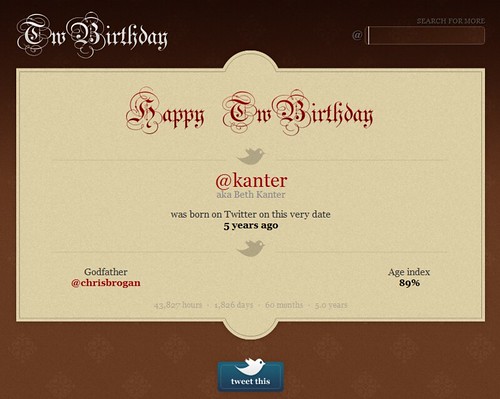
Last week, I celebrated my 5th birthday of joining Twitter! As far as I can tell, the first arrivals on Twitter from the NpTech sector were Ruby Sinreich and Brian Reich who signed up two weeks before me. So, in honor our collective Twitter birthdays in October and Halloween, I thought I’d share a few Twitter tools for tracking and learning that are real treats and a few that make your work flow on Twitter efficient for documenting events.
I track to learn and improve relationships on Twitter. I don’t bother with click rates or influence leader board scores. Some reflections questions I used to understand the data:
- What content/links are of interest to the people who are engaging with me?
- Who is regularly retweeting me?
- Is Twitter directing traffic and referrals to content for me and people in my network that I highlight?
- Who is interacting with me and I have replied to me or given them some Twitter love?
- Of the people I follow on Twitter and/or who follow me, who are the hubs within certain spheres? Am I interacting with them and supporting their work?
Do you need an easy way to track tweets from an event in real time? Want something free or very low cost? RowFeeder fits the bill. It will search hashtags or keywords and dump the data in a google spreadsheet. I used for anytime I teach a workshop or give a presentation. For example, here’s the spreadsheet from the workshop I facilitated that was hosted by Compasspoint. It makes really easy to do a quick content analysis, figure out what content resonated, and build community.
Susan Tenby from TechSoup Global told me about socialbro. It is a Twitter analytics tool. What’s cool about it is that you easily identify users that tweeted a hashtag. It offers many other useful features for those of you who are community managers on Twitter. I couldn’t actually use it because I have too many followers and it took too long to synch, but they’re coming out a version to handle this problem.
Crowdbooster is another Twitter analytics tool that gives you a lot of interesting charts and graphs and data. What I find most useful is the list of your top retweeters. Reciprocity is the secret to building a strong network – and understanding who is paying attention can help you give back some love.
Timely and Buffer do the same thing. They allow you load up your Tweets into que and then tweet them at the best times to get the most attention. They offer an analysis of click thrus and reach – and you can start to see patterns around good time to tweet. They both have chrome plugins that make it easy to add tweets w/links into your que. This has saved me so much time and bandwidth. I can do the seeking part of curation but I don’t have to share everything at once.
I’ve been looking for a tool like this and grateful that Avi Kaplan told me about Snapbird. It allows you to search beyond the Twitter history in search which is only a few days. I often need to do archaeological digs into Twitter and have been frustrated that I can’t go back – which means I have to capture in the moment and that’s a pain. Twitter history is useful for documentation and presentations. Here’s a few other tools that do the same and sift.
Storify is a content curation tool. It allows you to easily curate tweets and links and create a nice presentation. It’s my tool of choice for documenting Tweeting at conferences. Here’s an example of my storify for the recent Network Funders conference.
Tools are like candy – have a sugar high yet? Want more, see my big, messy list of social media tools.
What’s your favorite Twitter tool for learning and tracking or being efficient?

Leave a Reply